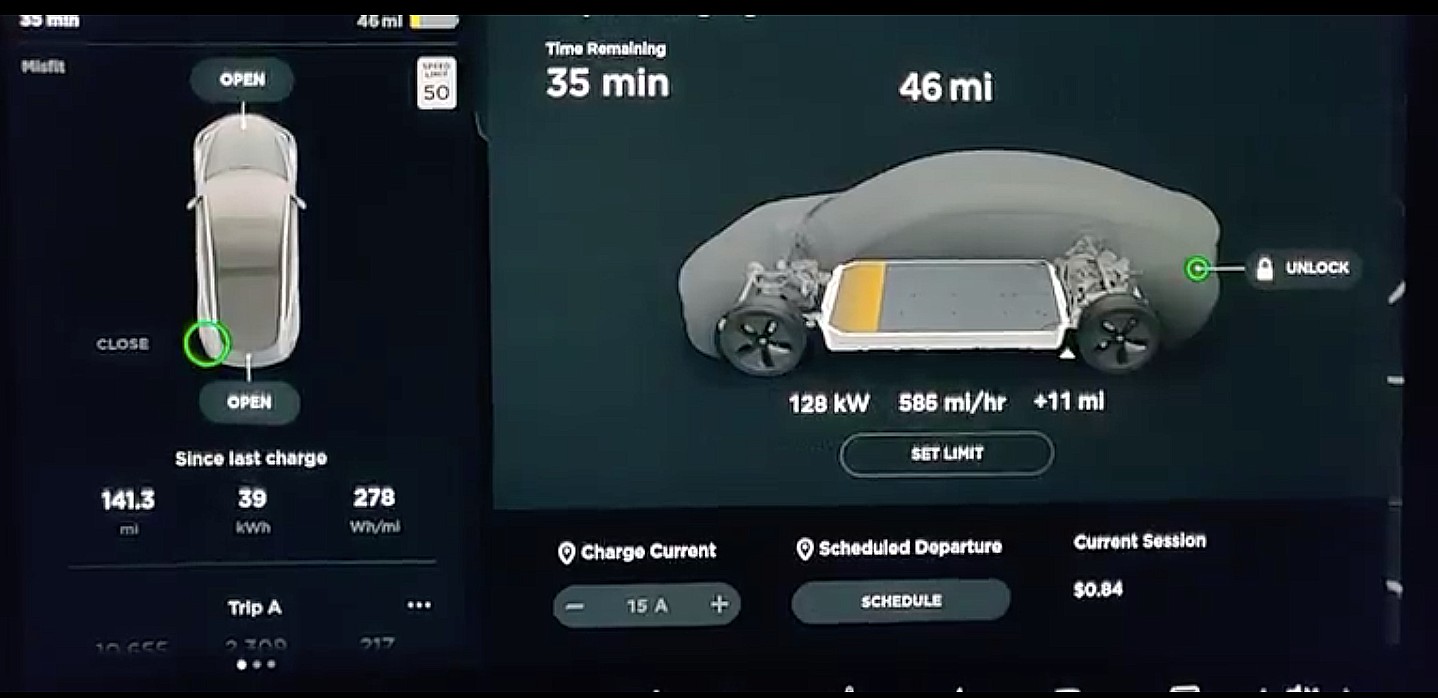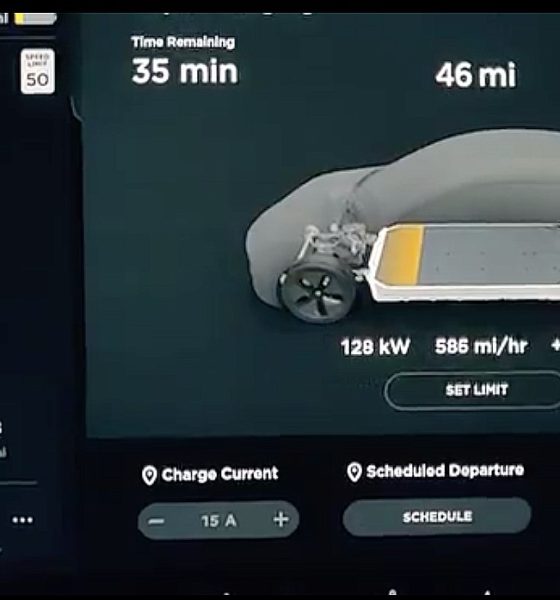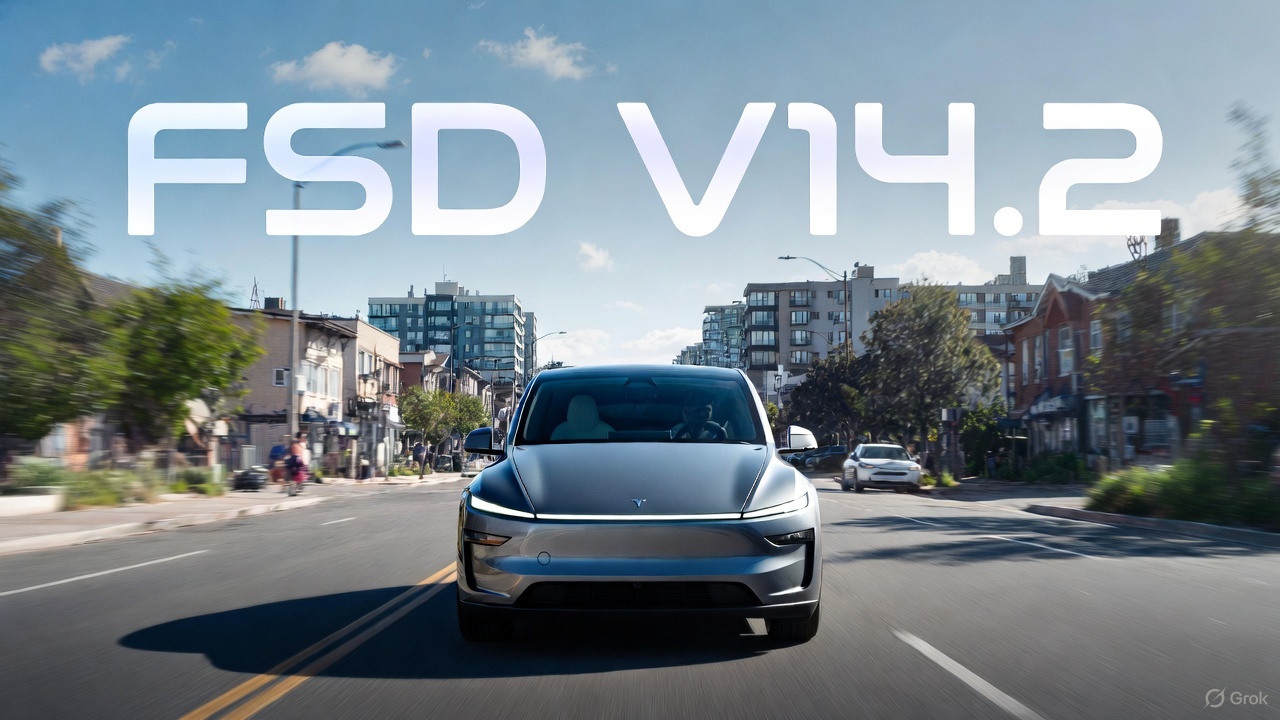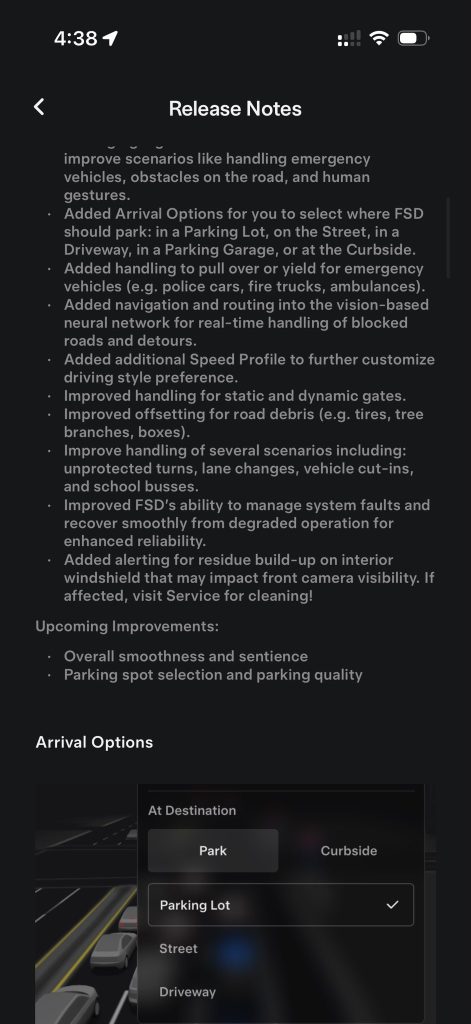

News
First look at Tesla Model 3 Standard Range Plus’ faster charging speed in action
A Tesla Model 3 Standard Range Plus owner recently demonstrated the improvements in his vehicle’s Supercharging speed following the release of the 2019.40.2.1 update. The over-the-air speed boost allows even lower-tier variants of the Model 3 to recharge their batteries at a rate that exceeds that of competitors.
In a post on Twitter, Tesla Model 3 owner @TeslaOwnersLV showed how his all-electric sedan was able to hit charging speeds of up to 601 mph. Prior to receiving the 2019.40.2.1 update, the Tesla enthusiast stated that his Model 3’s charging rate usually leveled off at around 100-106 kW.
Particularly interesting in the Model 3 owner’s video was the fact that the vehicle was not connected to Tesla’s fastest charger. It was taken at a V2 station, which has a maximum output of 150 kW. With a 250 kW V3 Supercharger, the Model 3 Standard Range Plus could charge at an even faster rate.
@Tesla @elonmusk
Taking advantage of the increase in charging rate (SR+) since update 2019.40.2.1
Thanks @elonmusk pic.twitter.com/eCKSqiBuan— Oh My Portugal! (@OhMyPortugal) December 16, 2019
Tesla has been rolling out improvements to the Supercharging speed of its more affordable vehicles as of late. In early November, Tesla released its version 2019.36.1 update, and one of its key upgrades was an increase in Supercharging peak power by 50-70%. Prior to the update, the Standard Range Plus Model 3 had a maximum 100 kW to 120 kW charge rate, which was ample but not on par with the charging speed of Tesla’s higher-tier vehicles.
The release notes for the Standard Range Plus’ charging speed boost were short and direct. “Your Model 3 is now able to charge with increased peak rate power up to 170 kW,” Tesla wrote. Yet, despite this simple description, the upgrade provided a great improvement to the user experience of the vehicle. Charging stops became shorter and faster, a big advantage for extended trips.
Confirmed! 2019.36.1 increases the peak supercharging power for Model 3 SR+ to 170kW. Source https://t.co/MTX9QHYj6P pic.twitter.com/fadz41eBlE
— Tesletter (@tesletter) November 3, 2019
But it’s not just the Standard Range Plus Model 3 that received a boost in Supercharging speeds. In late November, Tesla also introduced an increase in Supercharging peak power for the rare Mid-Range Model 3, raising its maximum charging speed to 200 kW with the Supercharger V3 Network. This was on top of the vehicle’s 5% performance boost, which reduced the Mid-Range Model 3’s 0-60 mph time to 4.9 seconds.
Tesla’s lead in battery tech and charging systems can be seen in how the company improves its vehicles’ specs over time. With its 170 kW peak charging rate, a sub-$40,000 Model 3 Standard Range Plus can replenish around 118 miles of its range in 10 minutes, provided that it is connected to one of Tesla’s 250 kW Supercharger V3 stations. In contrast, the $150,000 Porsche Taycan Turbo, with its 250 kW peak charging rate (at least for now), is able to recharge around 85 miles of its range in 10 minutes.
Along with faster Supercharging rates, the 2019.40.2.1 release notes talk about improvements in the Adjacent Lane Speeds feature, Automatic Wiper Fixes, and Autosteer Stop Sign Warnings.

Elon Musk
SpaceX Starship Version 3 booster crumples in early testing
Photos of the incident’s aftermath suggest that Booster 18 will likely be retired.

SpaceX’s new Starship first-stage booster, Booster 18, suffered major damage early Friday during its first round of testing in Starbase, Texas, just one day after rolling out of the factory.
Based on videos of the incident, the lower section of the rocket booster appeared to crumple during a pressurization test. Photos of the incident’s aftermath suggest that Booster 18 will likely be retired.
Booster test failure
SpaceX began structural and propellant-system verification tests on Booster 18 Thursday night at the Massey’s Test Site, only a few miles from Starbase’s production facilities, as noted in an Ars Technica report. At 4:04 a.m. CT on Friday, a livestream from LabPadre Space captured the booster’s lower half experiencing a sudden destructive event around its liquid oxygen tank section. Post-incident images, shared on X by @StarshipGazer, showed notable deformation in the booster’s lower structure.
Neither SpaceX nor Elon Musk had commented as of Friday morning, but the vehicle’s condition suggests it is likely a complete loss. This is quite unfortunate, as Booster 18 is already part of the Starship V3 program, which includes design fixes and upgrades intended to improve reliability. While SpaceX maintains a rather rapid Starship production line in Starbase, Booster 18 was generally expected to validate the improvements implemented in the V3 program.
Tight deadlines
SpaceX needs Starship boosters and upper stages to begin demonstrating rapid reuse, tower catches, and early operational Starlink missions over the next two years. More critically, NASA’s Artemis program depends on an on-orbit refueling test in the second half of 2026, a requirement for the vehicle’s expected crewed lunar landing around 2028.
While SpaceX is known for diagnosing failures quickly and returning to testing at unmatched speed, losing the newest-generation booster at the very start of its campaign highlights the immense challenge involved in scaling Starship into a reliable, high-cadence launch system. SpaceX, however, is known for getting things done quickly, so it would not be a surprise if the company manages to figure out what happened to Booster 18 in the near future.
News
Tesla FSD (Supervised) is about to go on “widespread” release
In a comment last October, Elon Musk stated that FSD V14.2 is “for widespread use.”

Tesla has begun rolling out Full Self-Driving (Supervised) V14.2, and with this, the wide release of the system could very well begin.
The update introduces a new high-resolution vision encoder, expanded emergency-vehicle handling, smarter routing, new parking options, and more refined driving behavior, among other improvements.
FSD V14.2 improvements
FSD (Supervised) V14.2’s release notes highlight a fully upgraded neural-network vision encoder capable of reading higher-resolution features, giving the system improved awareness of emergency vehicles, road obstacles, and even human gestures. Tesla also expanded its emergency-vehicle protocols, adding controlled pull-overs and yielding behavior for police cars, fire trucks, and ambulances, among others.
A deeper integration of navigation and routing into the vision network now allows the system to respond to blocked roads or detours in real time. The update also enhances decision-making in several complex scenarios, including unprotected turns, lane changes, vehicle cut-ins, and interactions with school buses. All in all, these improvements should help FSD (Supervised) V14.2 perform in a very smooth and comfortable manner.
Elon Musk’s predicted wide release
The significance of V14.2 grows when paired with Elon Musk’s comments from October. While responding to FSD tester AI DRIVR, who praised V14.1.2 for fixing “95% of indecisive lane changes and braking” and who noted that it was time for FSD to go on wide release, Musk stated that “14.2 for widespread use.”
FSD V14 has so far received a substantial amount of positive reviews from Tesla owners, many of whom have stated that the system now drives better than some human drivers as it is confident, cautious, and considerate at the same time. With V14.2 now rolling out, it remains to be seen if the update also makes it to the company’s wide FSD fleet, which is still populated by a large number of HW3 vehicles.
News
Tesla FSD V14.2 starts rolling out to initial batch of vehicles
It would likely only be a matter of time before FSD V14.2 videos are posted and shared on social media.

Tesla has begun pushing Full Self-Driving (Supervised) v14.2 to its initial batch of vehicles. The update was initially observed by Tesla owners and veteran FSD users on social media platform X on Friday.
So far, reports of the update have been shared by Model Y owners in California whose vehicles are equipped with the company’s AI4 hardware, though it would not be surprising if more Tesla owners across the country receive the update as well.
Based on the release notes of the update, key improvements in FSD V14.2 include a revamped neural network for better detection of emergency vehicles, obstacles, and human gestures, as well as options to select arrival spots.
It would likely only be a matter of time before FSD V14.2 videos are posted and shared on social media.
Following are the release notes of FSD (Supervised) V14.2, as shared on X by longtime FSD tester Whole Mars Catalog.


Release Notes
2025.38.9.5
Currently Installed
FSD (Supervised) v14.2
Full Self-Driving (Supervised) v14.2 includes:
- Upgraded the neural network vision encoder, leveraging higher resolution features to further improve scenarios like handling emergency vehicles, obstacles on the road, and human gestures.
- Added Arrival Options for you to select where FSD should park: in a Parking Lot, on the Street, in a Driveway, in a Parking Garage, or at the Curbside.
- Added handling to pull over or yield for emergency vehicles (e.g. police cars, fire trucks, ambulances.
- Added navigation and routing into the vision-based neural network for real-time handling of blocked roads and detours.
- Added additional Speed Profile to further customize driving style preference.
- Improved handling for static and dynamic gates.
- Improved offsetting for road debris (e.g. tires, tree branches, boxes).
- Improve handling of several scenarios including: unprotected turns, lane changes, vehicle cut-ins, and school busses.
- Improved FSD’s ability to manage system faults and improve scenarios like handling emergency vehicles, obstacles on the road, and human gestures.
- Added Arrival Options for you to select where FSD should park: in a Parking Lot, on the Street, in a Driveway, in a Parking Garage, or at the Curbside.
- Added handling to pull over or yield for emergency vehicles (e.g. police cars, fire trucks, ambulances).
- Added navigation and routing into the vision-based neural network for real-time handling of blocked roads and detours.
- Added additional Speed Profile to further customize driving style preference.
- Improved handling for static and dynamic gates.
- Improved offsetting for road debris (e.g. tires, tree branches, boxes).
- Improve handling of several scenarios, including unprotected turns, lane changes, vehicle cut-ins, and school buses.
- Improved FSD’s ability to manage system faults and recover smoothly from degraded operation for enhanced reliability.
- Added alerting for residue build-up on interior windshield that may impact front camera visibility. If affected, visit Service for cleaning!
Upcoming Improvements:
- Overall smoothness and sentience
- Parking spot selection and parking quality








